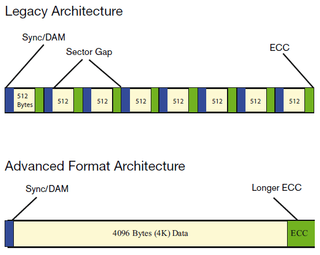HDDs, The Next Generation: Drives With 4KB Sectors On The Way

Larger Sectors, More Capacity, New Issues
Samsung has had a few hard drives that use sector sizes larger than the usual 512 bytes, such as the Spinpoint M7E and the portable S1 Mini. However, it is Western Digital that has launched a new product line, the EARS-series, and moved 4KB sectors into the mainstream. The reason for this change is an increase in net storage capacity due to decreased amounts of ECC information resulting from the larger sector size. We picked a Western Digital Caviar Green 1TB (WD10EARS) as a case study in the new technology.
Advanced Format
This term is specific to Western Digital, which refers to its latest 4K products as Advanced Format Drives. However, the term really means that the sector size has advanced from 512 bytes to 4KB. The main purpose is to increase capacity, but the actual implementation is not trivial.
Hard Drive Fundamentals
Hard drives consist of one or multiple rotating platters coated with a magnetizable surface. Heads mounted at the end of an arm take care of reading or writing on the surface, somewhat like the needle of a record player. In this case, though, heads are available on both sides of the platters.
The surface of each platter is organized in concentric tracks. Each track consists of various sectors (our main focus in this article), and each sector holds a certain number of bits. Whether a bit has the value 0 or 1 is determined by its magnetic properties. All of the latest hard drives are based on so-called perpendicular magnetic recording technology, meaning that the magnetic grains on the platter surface are aligned vertically instead of horizontally, as on older generation of longitudinal recording drives. Perpendicular recording, also known as PMR, has allows for much higher data density, expressed in gigabits per square inch (Gb/inch²).
Ways to Increase Capacity
Stay on the Cutting Edge
Join the experts who read Tom's Hardware for the inside track on enthusiast PC tech news — and have for over 25 years. We'll send breaking news and in-depth reviews of CPUs, GPUs, AI, maker hardware and more straight to your inbox.
The traditional and most common way to increase capacity is through an increase in storage density. While Gb/inch² is the technically accurate way of expressing storage density, it's also common to talk about capacity per platter. A modern 3.5” hard drive can store 500GB per platter based on traditional 512 byte sectors. Meanwhile, 2.5” notebook hard drives are still at 320GB per platter. Obviously, a larger number of platters will also increase the total capacity, but this also increases cost and the number of moving parts.
Large Sector Size means Less Overhead

A larger sector size results in higher net capacities because it decreases the amount of ECC data and the inter-sector margins. WD says that going from 512 bytes to 4KB sector size results in a net capacity increase of 7 to 11 percent. ECC efficiency could also increase, as one long ECC code requires less computation than multiple small chunks. However, there are a few issues that users should be aware of.
Current page: Larger Sectors, More Capacity, New Issues
Next Page WD’s EARS SeriesMost Popular

